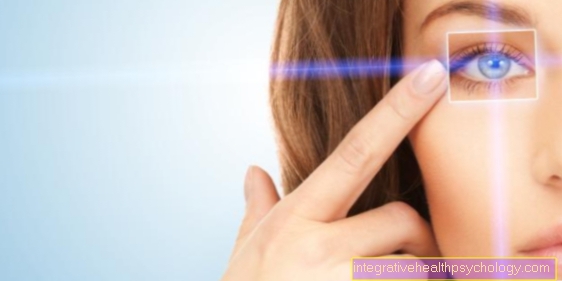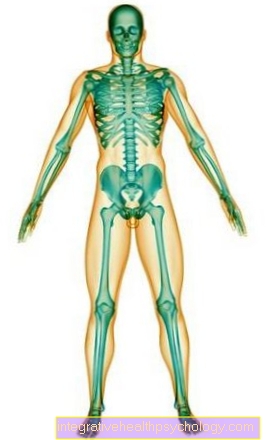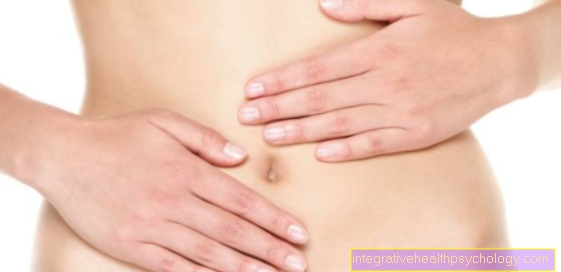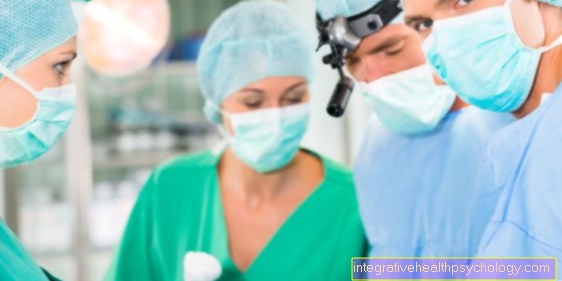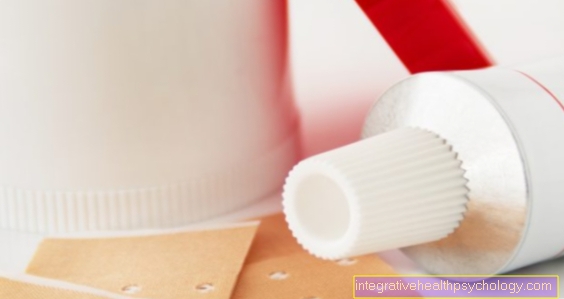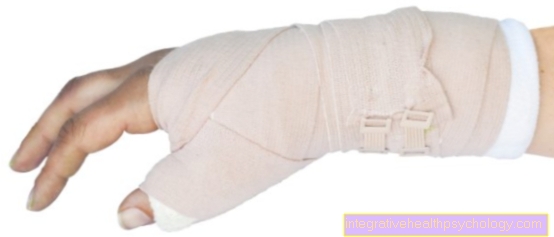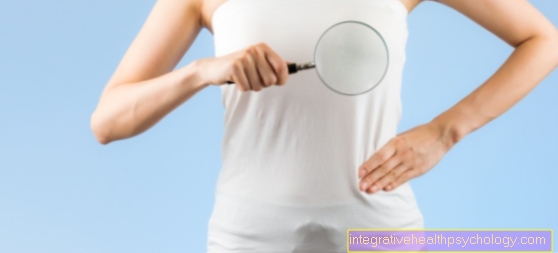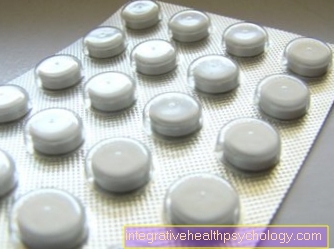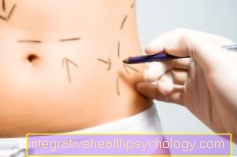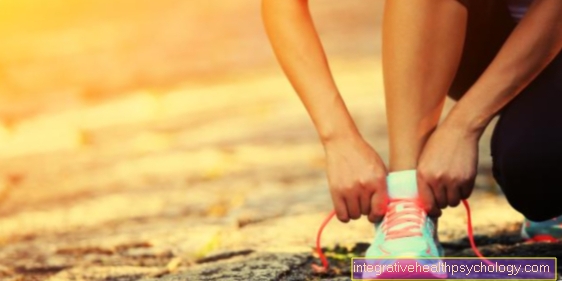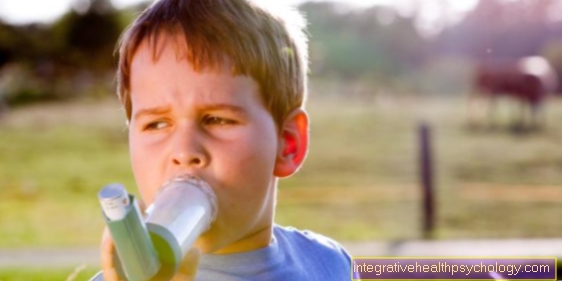Livocab eye drops
introduction
Eye drops are liquid solutions that can be given into the eye in the form of individual drops.
Livocab® eye drops also contain Livocab®, which corresponds to the active ingredient levocabastine. The Livocab® eye drops are mostly used for allergic diseases of the eyes and can be used on children from one year.
Area of application for Livocab® eye drops
Livocab® eye drops contain the active ingredient levocabastine. This can be used for conjunctivitis of the eyes if this is caused by an allergic reaction.
Another consideration is the so-called conjunctivitis vernalis, which is also a presumably allergic conjunctivitis that occurs particularly in spring, and occasionally in autumn. In addition to swelling and reddening of the conjunctiva in the eye, there is also a feeling of foreign bodies.
Also read: Treatment of conjunctivitis
Livocab® eye drops for hay fever
Livocab® eye drops are used for hay fever with involvement of the eyes.
Hay fever is caused by an allergic reaction that can affect the airways, the mucous membranes of the nose and also the eyes. Typically, itchy, burning, reddened and watery eyes. In addition, affected people have a persistent cold. If the airways are more severely affected, asthmatic symptoms with shortness of breath can also be caused.
Hay fever is mainly triggered by pollen and other plant components that can be found in the air, especially in spring. The active ingredient levocabastine, which is contained in the Livocab® eye drops, is a substance from the group of H1 antihistamines. Histamine is a tissue hormone that plays an important role in the development of allergic reactions such as hay fever. As an antihistamine, levocabastine works against this hormone, preventing or reducing the allergic reaction to pollen and grasses.
While other antihistamines can also be used as tablets or sprays for the nose and the respiratory tract, the Livocab® eye drops work specifically against the allergic reaction of the mucous membranes (= conjunctiva) in the eye. There they reduce the itching and stinging of the eyes through their anti-allergic effect. In addition, the conjunctiva is less reddened and irritated by the Livocab® eye drops.
Livocab® nasal spray can also be used for hay fever. Read more about this at: Livocab® nasal spray
For more information on this topic, we also recommend: Medicines for hay fever
When should Livocab® eye drops not be given?
Contraindications for Livocab® eye drops exist in case of allergies or hypersensitivity to the active ingredient levocabastine or to other ingredients of the eye drops. Other ingredients that could be allergic to are propylene glycol, disodium hydrogen phosphate, sodium hydrogen phosphate, hypromellose, polysorbate and benzalkonium chloride.
Side effects of Livocab® eye drops
Side effects caused by the use of Livocab® eye drops are rather rare or harmless.
Like many other active ingredients that are used in the eye, Livocab® eye drops can also irritate the eyes. Under certain circumstances, this can increase the burning and itching and also lead to reddening of the conjunctiva and the sclera (the white of the eyeball). Increased vascular injection (formation of visible vessels on the white eyeball) can also occur as a side effect when using Livocab®.
In addition, hypersensitivity to other ingredients in Livocab® eye drops can cause an allergic reaction in the eye. When using the eye drops, temporary blurred vision can also occur. This is often due to the amount of fluid suddenly found in the eye.
Normally, when using Livocab® eye drops, there is no systemic (throughout the body) effect of the ingredient levocabastine. At particularly high doses, however, slight systemic side effects can also become noticeable. Typically, there is increased fatigue and exhaustion. Affected people are usually exhausted more quickly, but it is not always clear whether this is triggered by the Livocab® eye drops or by the hay fever itself. You may also experience dizziness, headaches and a feeling of weakness when using the eye drops.
Interactions of Livocab® eye drops
There are no known interactions with other drugs with Livocab® eye drops. In the case of eye drops, this is mostly due to the fact that the active ingredient only works locally on the eye and is only absorbed into the body in very small quantities. However, Livocab® eye drops should not be used together with other eye drops.
No interactions are known for the active ingredient levocabastine. So far, there have been no reports of interactions with other drugs when taking levocabastine in the form of tablets, injections or ointments.
Interactions with the pill
There are no known interactions with other drugs for Livocab® eye drops. So far, there is no evidence that the eye drops or the active ingredient levocabastine interact with other forms of administration (tablets, injections, etc.) with contraceptives. It is therefore assumed that the pill can also develop its normal effect when using Livocab® eye drops.
How should you dose Livocab® eye drops?
Livocab® eye drops can be used in children from the age of one year. For them, according to the manufacturer, the dosage that is also taken in adolescents and adults applies.
In the case of hay fever, one drop can be put into each eye twice a day. The maximum recommended dose is one drop in each eye up to four times a day. For children under one year, however, the Livocab® eye drops have not been tested, which is why no dosage information is possible here.
How expensive are Livocab® eye drops?
Depending on the dosage and size of the pack, Livocab® eye drops are available for prices between five and twenty euros. The eye drops are only available in pharmacies and can therefore only be bought in pharmacies.
Livocab® eye drops can also be purchased online through online pharmacies.
In addition, the eye drops are available without a prescription, so you don't need a prescription from a doctor to buy the Livocab® eye drops. Usually, however, the prescription-free option also means that the costs for the eye drops are not covered by health insurance companies and private health insurers.
Livocab® eye drops during pregnancy and breastfeeding
There are no adequate human studies available on the use of Livocab® eye drops during pregnancy. In animal experiments, no dangerous effects for the unborn or breast-fed child have been found, but there are no official studies that show the safety of the use of Livocab® eye drops during pregnancy and breastfeeding.
During breastfeeding, it has been shown that about 0.3% of the levocabastine dose given in the eye is found in the saliva and breast milk of women. Therefore, a risk to a breastfed child cannot be excluded. Use during breastfeeding is therefore not recommended.
Alternatives to Livocab® eye drops
There are many different preparations on the market for using eye drops for hay fever.
Some of the products are used purely for calming eyes afflicted by allergies. These include, for example, Hylo-Care® eye drops, Vividrin® eye drops and Bepanthen® eye drops.
Allergodil® akut also works against itching because it contains the active ingredient azelastine. This prevents histamine from reaching the mucous membranes of the eye. Other antihistamine eye drops are, for example, Cromo-ratiopharm® eye drops.
Read more about the alternatives on our main page: Eye drops and eye ointments
For more information, see:
- Vividrin® eye drops
- Bepanthen® eye drops


.jpg)
